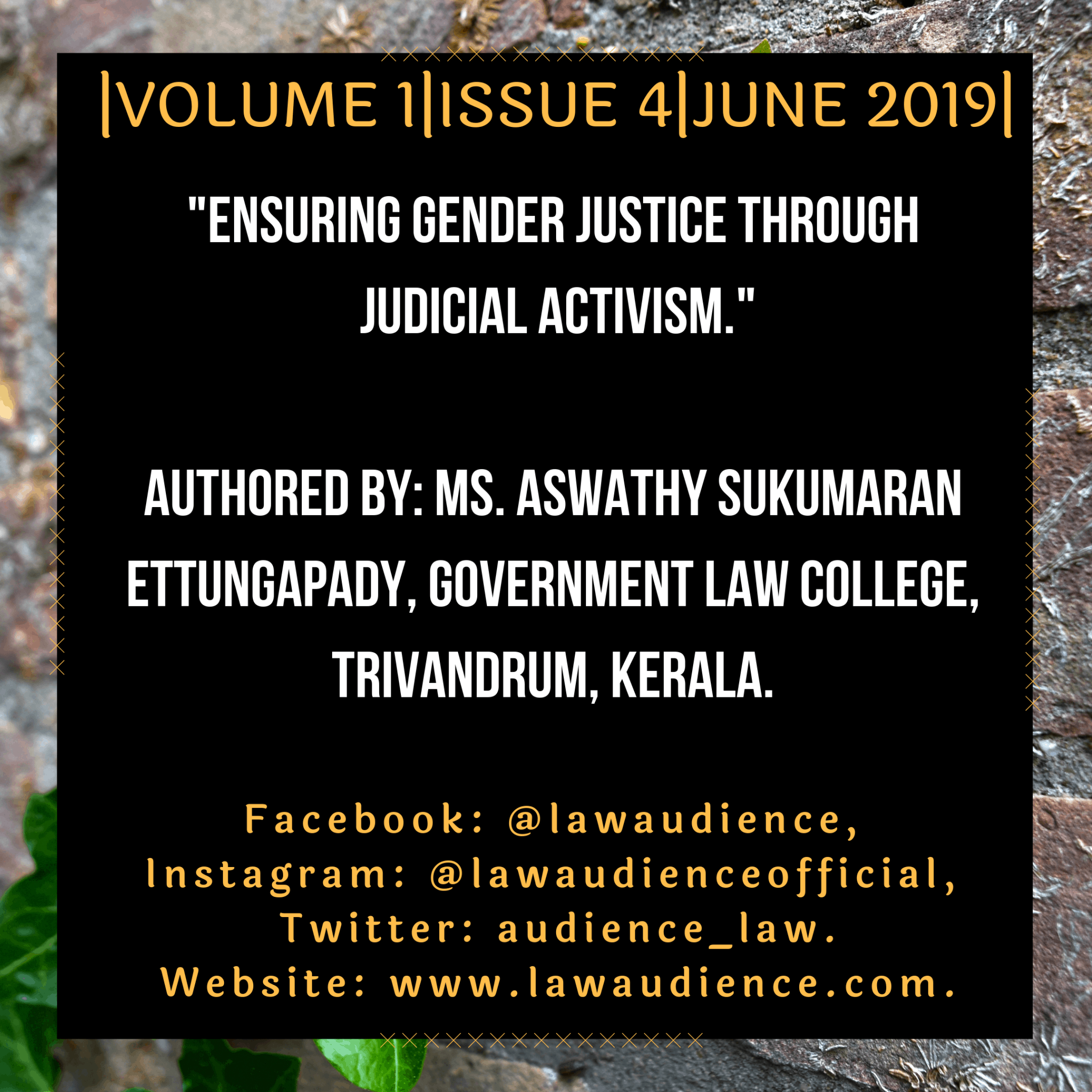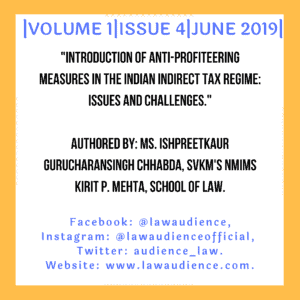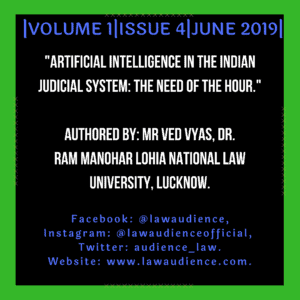Authored By: Ms. Aswathy Sukumaran Ettungapady, Government Law College, Trivandrum, Kerala.
I. ABSTRACT:
“Judicial activism is a term used to describe the assertiveness of judicial power. It is gaining momentum day by day with an important role to play particularly in matters relating to the violation of Human rights, Women’s rights, Child rights, Environment and Ecology etc. The Supreme Court of India has evolved its gender jurisprudence over the years and has exhibited an optimistic, progressive and activist attitude towards gender-specific issues and thereby took a bold move towards securing gender justice. The women’s rights movements all over the world and the international recognition of women’s rights are some of the factors that have influenced the honourable Court’s stance towards gender justice. The Supreme Court in various occasions has come forward to address women issues as issues of human right violations and has widened the scope of the fundamental right to life to include the rights of women as well. Judicial activism is used as an instrument in bringing social change.
Through a plethora of cases, the Honourable Court has avowed the rights to privacy, bodily integrity, faith, choice, equality of status and equal opportunities, dignity and right against exploitation. At instances, the Court has even stepped into the shoes of law-making to remove the fetters imposed by law and society on the rights of women. The ambit of activism extends further from the social spectrum of the women to the four walls of her matrimonial home as well. The recent judgments of the Supreme Court on adultery and temple entry have broken the gender stereotypes that existed for centuries and have created new milestones in gender justice.”
II. ENSURING GENDER JUSTICE THROUGH JUDICIAL ACTIVISM: AN INTRODUCTION:
From time immemorial women are subjugated and treated as a weaker section of the society. In all walks of life, she is exploited and treated unjustly by her counterpart. Even in the new millennium, Women’s rights encounter stiff resistance from the traditional paradigm of human rights which are men-centric. This can be seen in the conflicts between the right to entry into temples against society’s conception of morality and religious practices. Gender justice is still a concept anonymous and remote to many sections of society. Gender justice remains eluded even from the laws of many countries. Gender justice entails ending the inequalities between women and men that are produced and reproduced in the family, the community, the market and the state. It also requires that mainstream institutions from justice to economic policymaking are accountable for tackling the injustice and discrimination that keep too many women poor and excluded[1].
In India, all wings of the government namely, legislature, executive and judiciary at the Central, State and local levels have the responsibility towards empowerment of women in the light of fundamental rights and directive principles of state policy, which give a ground for purposive interpretation of Constitutional feminism[2]. The Supreme Court of India is the most revered the most adulated and probably the least studied of the Indian Judicial bodies[3]. Over the years it has played an important role in the lives of the common man of the country through its multi-dimensional humanitarian judgments. The higher judiciary has evolved over the years to be the defender and protector of the interest of the most vulnerable class of the Indian population. These developments were possible through judicial activism. An important issue that has assumed significance in recent times has been the activist role played by the Indian judiciary especially the Supreme Court[4].
The Supreme Court has come to its own, as an institution only in the 1980s. The Court demonstrated that it can be as active as any other judiciary in the world. The Court commenced its dynamic role in safeguarding and protecting the fundamental rights of the citizens by putting an effective check on the executive and legislature[5]. The relaxation of the rules of locus standi also distended the activist role of the Supreme Court. According to Indian jurist Upendra Baxi, judicial activism is that way of exercising judicial power which seeks fundamental recodification of power relations among the dominant institutions of State, manned by members of the ruling classes[6]. He further points out that judicial activism is the use of judicial power to articulate and enforce counter ideologies which when effective initiates significant re-codifications of power relations within the institutions of governance[7].
Retired Honourable Supreme Court Chief Justice Dr A.S. Anand writes in his book, “The process of gender justice, broadly speaking, covers rights of women against exploitation and victimisation. Today the fact is that women’s exploitation is a reality and gender justice is a fragile myth.[8]”
He further adds and explains the concept of judicial activism:
“The judiciary can neither prevaricate nor procrastinate. It must respond to the knock of the oppressed and the downtrodden for justice by adopting certain operational principles within the parameters of the Constitution and pass appropriate directions in order to be renderful and effective relief. Judicial activism encompasses an area of legislative vacuum in the field of human rights. In my opinion, judicial activism reinforces the strength of democracy and reaffirms the faith of the public in the Rule of Law.”
The reasons for judicial activism are explained differently by different jurists, starting from the near collapse of responsible government, pressure on the judiciary to step in aid, judicial enthusiasm to participate in social reform and change, legislative vacuum, public confidence in the judiciary, the role of the judiciary as guardian of fundamental rights etc.
Women’s legal manifestations have been that of a special case, a category separate from men and the male norm on which the spotlight falls. The law has remained silent on major aspects of women’s existence so much so that she has on occasions been dwarfed to the level of a child, to the extent that makers of the Constitution fall prey to it[9].
III. JUDICIAL DECISIONS ON ENSURING GENDER JUSTICE:
Gender-based stereotyping enjoined on the patriarchal ideology has been rooted in India for centuries and many of them have over the years crept into the country’s legal system. The historic injustices done by society towards women were even visible in the judicial decisions as well. The infamous Mathura Rape Case[10], Nandan Kanan Rape Case[11], Raju’s Case[12], Soumithri Vishnu Case[13], M. Kishwar vs. State of Bihar[14], are profound examples of the conservative and patriarchal approach taken by the Apex Court. The judgments of the Court in case of Soumitri Vishnu vs. Union of India[15], and which was subsequently followed in Revathi vs. Union of India[16], were actually anti-gender justice decisions. In the pseudo name of protection, it actually widened further the inequalities faced by women in the wedlock.
Remnants of judicial activism in India can be traced back to the pre-independence period. Justice Robert Hill Pinhey, in one of the most revolting and path-breaking judgments of his time on women emancipation in the famous case of Dadaji Bhikaji vs. Rukhmabai[17], in a suit for restitution of conjugal rights in the Bombay High Court. 11-year-old Rukhmabai was married to 19 years old Dadaji Bhikaji. She questioned the validity of her marriage with Dadaji. The case caused a lot of disturbance among the conservative minds of the society, who indeed were the majority. It raised multiple debates on subjects like women education, child marriages, consent, Hindu law, customs and traditions etc.
Pinhey J. held that, “It seems to me that it would be a barbarous, a cruel, a revolting thing to do to compel a young lady, under those circumstances, to go to a man whom she dislikes, in order that he may cohabit with her against her will.”
However, Pinhey succeeded in drawing attention to the vexed question of the relationship between morality and law, and in embedding the case within a broader legal-humanitarian framework. His verdict made the case inseparable from the women’s cause. There was no chance for those who sought to make it a private matrimonial dispute[18].
The Indian judiciary has also shown a mixed trend over the years towards the issues of women. While the period immediately after Independence, up to the seventies witnessed a conservative and narrow-minded judicial system, the late eighties and nineties have seen the emergence of judicial activism which reached its heights recently. The year 2018 has been one such year where the Supreme Court had decided to throw away many such gender-based stereotypes and inequalities thrust upon by the society upon women.
In C.B.Muthamma vs. Union of India[19], the Supreme Court struck down the discriminatory rules of the Indian Civil Services against women on the ground that they violated the fundamental right of women employees to equal treatment in matters of public employment. Justice Krishna Iyer has stated that,
“Freedom is indivisible, so is justice. That our founding faith enshrined in Articles 14 and 16 should have been tragically ignored vis-à-vis half of India’s humanity, viz., our women is a sad reflection on the distance between Constitution in the book and law in action[20].”
In Nargesh Meerza’s Case[21], the Supreme Court struck down the Air India Regulations relating to retirement and pregnancy bar on the services of Air hostesses as unconstitutional on the ground that the conditions laid down therein were entirely unreasonable and arbitrary.
The nineties beaconed, the emergence of a new era of judicial activism and dynamism towards rape laws. It witnessed the rekindling of the hearts of the Indian judges towards the cause of justice. The modern scientific and technological developments taking place in the society, as well as the enlightenment of the inner conscience of the people at large, no doubt, had its effect on the judicial process, and it revived its energies to forge new tools and devise new remedies for the purpose of safeguarding the rights and liberties of the people, especially women[22].
In the historic judgment on gender equality in the case of Githa Hariharan vs. RBI[23], the Supreme Court held that the mother can act as a natural guardian even when the father is alive.
In Neera Mathur vs. L.I.C.[24], the Court recognised woman’s right to privacy in respect of information regarding her reproductive functions. It held that the questionnaire that sought information on the dates of the menstrual periods and past pregnancies amounted to an invasion of the privacy of a person and therefore could not be made.
The Supreme Court of India has in cases like Govt. of A.P. vs. P.B. Vijayakumar[25], Union of India vs. K .P. Prabhakaran[26], the Supreme Court has held that protective discrimination can be made under Article 15(3) of the Constitution.
The Supreme Court has demonstrated great judicial activism while coming to rescue of the working women even at the cost of resorting to judicial activism under Article 141 of the Constitution. To combat the sexual harassment experienced by women at workplaces the Court stepped into the shoes of the lawmaker and issued directions in the sensational case of Vishaka vs. State of Rajasthan[27].
In a PIL filed before the Supreme Court emphasised the need for effective legislation in India to curb sexual harassment of working women. The Court followed this decision again in Apparel Export Promotion Council vs. A. K. Chopra[28].
Justice K Rama Swamy in Madhu Kishwar vs. State of Bihar[29], observed that, “Half of the Indian population too are women. Women have always been discriminated against and are suffering discrimination in silence. Self-sacrifice and self –denial are their nobility and fortitude and yet they have been subjected to all inequalities, indignities, inequality and discrimination.”
Even though the State has not yet made any effort to introduce Uniform Civil Code in India, the judiciary has recognised the necessity of the uniformity in the application of civil laws like the law of marriage, succession, adoption and maintenance etc., in the case of Sarla Mudgal vs. Union of India[30], and other cases[31].
Through cases like Mary Roy[32], the Apex Court has executed key verdicts on women’s equal rights over the property. In C .M. Mudaliar vs. Idol of Sri S. Swaminanthaswami Thirukoil[33], the Supreme Court has highlighted the right of women in India to eliminate gender-based discrimination particularly in respect of property so as to attain economic empowerment[34].
In Gaurav Jain vs. Union of India[35], the Court speaking through Justice K. Ramaswamy has elaborately dealt with the issue pertaining to the rescue and rehabilitation of prostitutes and also their children which have far-reaching circumstances. The court also issued guidelines for the same.
The Court exercised judicial activism and imparted a revolutionary and ground-breaking judgment in the case of Bodhisattwa Gautam vs. Subhra Chakraborty[36], wherein it was held that rape is a crime that violates the right to life under Article 21 and described it as ‘deathless shame and the gravest crime against human dignity’ and ordered interim compensation to the rape victims. The Court recognised that fundamental rights can be enforced even against private bodies and individuals[37].
Decisions of the Supreme Court have had a remarkable impact on rape victim justice movement. An increased sensitivity towards the plight of the victims is particularly noticeable in the landmark case of State of Punjab vs. Gurmit Singh[38]. Justices Dr AS Anand and Saghir Ahmad made some revolutionary and ground-breaking observations in this case and provided guidelines that should be observed by the Courts during rape trials.
The judiciary has on many occasions, while convicting the accused of rape, ordered compensation to be paid to the hapless victims. In the Delhi Domestic Working Women’s Forum vs. Union of India[39], the Indian judiciary has laid down the following broad parameters in assisting the victims of rape, in line with the core guidelines of International documents.
In yet another landmark case, Chairman, Railway Board vs. Chandrima Das[40], the Court asked railways to pay rupees 10 lakh as compensation to the prosecutrix for the rape committed by some railway officials in the railway restroom.
In State of Maharastra vs. Mahukar Narayan Mardikar[41], the Supreme Court held that even a prostitute has a right to privacy under Article 21, and no person can rape her just because she is a woman of easy virtue.
The very recent decisions of the Supreme Court beginning from the TRIPLE TALAQ case to the very controversial SABARIMALA case, the Supreme Court has showcased a never before proactive role in ensuring gender justice not only in the best interest of women but in the interest of the whole of humanity. The abolition of the practice of triple talaq by the Supreme Court has brought in a positive wave towards uniform civil code.[42] The Court has ended a religious practice that demands wives to be in servitude to their husbands.
On 6th September 2018, another historic and progressive judgment was passed by the Chief Justice Deepak Misra by reading down Section 377 IPC by decriminalising homosexuality. The judgment is one of the most prominent judgments passed by the Honourable Supreme Court in ensuring gender justice[43].
Again in the case of Joseph Shine vs. Union of India[44], the Court overruled its own judgment in the case of Sowmithri Vishnu vs. Union of India & Anr.,[45] by decriminalising adultery and striking it off the Indian Penal Code holding that the law was based on gender stereotypes and thus violated Articles 14 and 15 of the Constitution as the law considered only the husband of the adulteress aggrieved while the wife of the adulterer had no interests. The Court went a step ahead and held that adultery itself cannot be made an offence as subjecting interpersonal relationships to the rigours of criminal law would amount to an unwarranted intrusion into the right to privacy.
Off late, the Court has lifted the ban on women of 10 to 50 years from temple entry at Sabarimala in Kerala[46]. Justice Deepak Misra has pointed out the inequalities persistent in modern society based on gender.
“..The dualism that persists in religion by glorifying and venerating women as goddesses on one hand and by imposing rigorous sanctions on the other hand in matters of devotion has to be abandoned. Such a dualistic approach and an entrenched mind-set result in indignity to women and the degradation of their status. The society has to undergo a perceptual shift from being the propagator of hegemonic patriarchal notions of demanding more exacting standards of purity and chastity solely from women to be the cultivator of equality where the woman is in no way considered frailer, lesser or inferior to man.”
IV. CONCLUSION:
The heavy protests that followed the Sabarimala Court order and still continues, indicates that judicial activism has travelled ahead of its time in ensuring gender justice while the conservative and patriarchal society disavows these vicissitudes. It is indeed an hour of intense pride that judiciary is finally taking cognisance of the atrocities and injustices levelled against women for ages. Sometimes laws have to act as instrumentalities for social change. The women clenched in the deep roots of patriarchy entrenched in the Indian society for aeons, calls for judicial interference to free them.
There have been many criticisms levelled against the buzz created by judicial activism with respect to the separation of powers. But the sad reality is that it is the dormancy and inertness of the other two constitutional bodies that call for the interference of the judiciary and ensure administration of justice. In order to safeguard the constitutional values enshrined by our forefathers and to remove the impediments imposed on women in their enjoyment of these freedoms and rights without the constraints imposed on them by the gender stereotypes, judicial activism is the only remedy available.
It is sometimes unfortunate that in a democratic country like India the higher judiciary has to take an activist approach in the decision-making process. The new and improved attitude of the Courts in rectifying their past decisions placing them on the threshold of the demands of modern society as in the case of adultery and same-sex marriages shows the new attitude of the Courts towards positive affirmative actions. A dynamic society needs a dynamic and enthusiastic judiciary.
[1] A. Goetz, Gender Justice, Citizenship and Entitlements: Core Concepts, Central Debates and New Directions for Research, in Gender Justice, Citizenship and Development, edited by Mukhopadhyay, M. and N. Singh (2007).
[2] Mamta Rao, Law Relating To Women And Children, 17, (3rd edn , 2012).
[3] Dr. G. B. Reddy, Judicial Activism in India, (2nd edn., 2013).
[4] Id at 5.
[5] Id at 9.
[6] Upendra Baxi, Courage Craft and Contention- The Indian Supreme Court in the Eighties, 10, (1985).
[7] Id at 13.
[8]Retd. C.J. Dr A.S. Anand , Justice for Women, Concerns And Expressions, 5, (3rd edn. 2008).
[9] Lalitha Dhar Parihar, Women & Law from Impoverishment to Empowerment- A Critique, (1st edn. 2011).
[10] Tukaram vs. State of Maharashtra, (1979) 2 S.C.C. 143 (India).
[11] Pratap Mishra vs. State of Orissa, A.I.R. 1977 S.C. 1307 (India).
[12] Raju vs. State of Karnataka, A.I.R. 1994 S.C. 222 (India).
[13] Sowmithri Vishnu vs. Union of India, 1985 Supp S.C.C. 137 (India).
[14] (1996) 5 S.C.C. 125 (India).
[15] A.I.R. 1985 S.C. 1618 (India).
[16] A.I.R. 1988 S.C. 835 (India).
[17] (1885) ILR 9 Bom 529 (India).
[18] Sudhir Chandra, Enslaved Daughters, Colonialism, Law and Women’s Rights, 41, (2nd Edn. 2008).
[19] (1979) 4 S.C.C. 260 (India).
[20] Id at 262.
[21] Air India International vs. Nargesh Meerza, (1981) 4 S.C.C. 335 (India).
[22] Dipa Dube, Rape Laws in India, 105, (2008).
[23] (1992) 2 S.C.C. 228 (India).
[24] (1992) 1 S.C.C. 286 (India).
[25] A.I.R. 1995 S.C. 1648 (India).
[26] (1997) 11 S.C.C. 638 (India).
[27] (1997) 6 S.C.C. 241 (India).
[28] 1999 (1) Supreme 110 (India).
[29] (1996) 5 S.C.C. 148 (India).
[30] (1995) 3 S.C.C. 635 (India).
[31] G.B. Reddy, Women and law, (2001).
[32] Mary Roy vs. State of Kerala, 1986 A.I.R. 1011 (India).
[33] (1996) 8 SCC 525
[34] G.B Reddy, Supra, 8.
[35] (1997) 8 S.C.C. 114 (India).
[36] (1996) 1 S.C.C. 490 (India).
[37] Id at 499.
[38] A.I.R. 1996 S.C. 1393 (India).
[39] (1995) 1 S.C.C. 14 (India).
[40] (2000) 2 S.C.C. 465 (India).
[41] (1991) 1 S.C.C. 57 (India).
[42] Shayara Bano vs. Union of India & Others, (2017) 9 S.C.C. 1 (India).
[43] Navtej Singh Johar & Ors.vs. Union of India thr. Secretary Ministry of Law and Justice, Writ Petition (Criminal) no. 76 of 2016 (India).
[44] Writ Petition (Criminal) no. 194 of 2017 (India).
[45] 1985 A.I.R. 1618 (India).
[46] Indian Young Lawyers Association & Ors. vs. State of Kerala & Ors. Writ petition (civil) no. 373 of 2006 (India).



